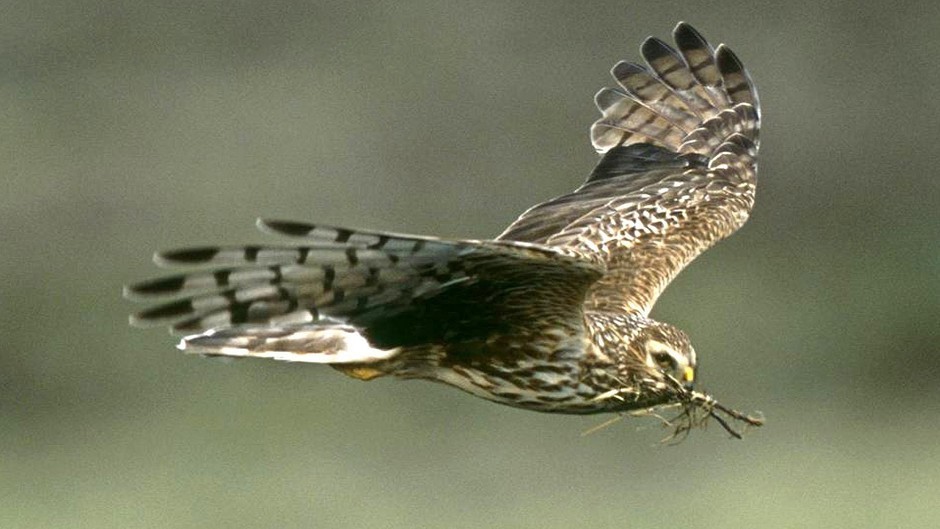Callous criminals have set traps to catch and kill some of Scotland’s most iconic birds of prey on a shooting estate bordering the Queen’s Deeside summer retreat.
A common gull had to be put down after being found snared by two walkers in the Cairngorm National Park.
A dead rabbit had been used as bait, and last night RSPB Scotland investigators said they had found evidence of eight more spring traps at Geallaig Hill on the Invercauld Estate near Ballater.
They were attached to stakes and also baited with dead animals.
The RSPB said the gull was not the intended victim of the trap – and that it was “almost certainly targeting birds of prey”.
The charity – which has contacted the police – said golden eagles, red kites and hen harriers were all “at serious risk” from the devices.
Last night, a spokesman for Invercauld Estate – which neighbours the Queen’s Scottish home at Balmoral Castle – stressed police searches had uncovered no evidence of illegal activity on its part.
Three dead gull chicks, which are believed to have starved to death, were found close to where the adult bird was discovered.
Hen harriers and golden eagles are all known to nest in the eastern Cairngorms.
Ian Thomson, RSPB Scotland’s head of investigations, said the find was evidence raptor persecution was still taking place in Aberdeenshire.
He added: “We obviously don’t have any idea how long this trapping operation had gone on.
“There is a fairly high likelihood that the gull trapped was not the first victim, they were only discovered by sheer luck.
“These are remote areas seldom accessed by members of the public.
“We don’t know whether we are detecting 5% or 95% of incidents in a given year.
“I am not going to point fingers at any individual or group of individuals but this is going on and on and on.
“And over 80% of raptor persecution between 1994 and 2014 was on land managed for game bird shooting.”
Peter Argyle – convener of the Cairngorm National Park Authority (CNPA) and Aboyne, Upper Deeside and Donside councillor – said: “The park are very concerned that it appears to be an instance of raptor persecution within the national park.
“We have had a number of instances in the eastern Cairngorms of raptors being shot, trapped or poisoned.
“I know the Scottish Government is looking at it very seriously.”
A spokesman for Invercauld Estate said: “We have spoken with the police who we understand searched the site and we have also undertaken our own internal investigation.
“We understand the police did not find evidence of illegal activity and our own inquiry has led to a similar conclusion.
“Nevertheless, we are extremely concerned by the allegations made in the RSPB press release and condemn outright any unlawful activity.”
Police have urged anyone with information to contact them on 101.
Traps designed to kill small animals
RSPB Scotland’s head of investigations Ian Thomson said the spring traps discovered were designed to kill small mammals.
He said when used on creatures such as stoats or weasels – which can legally be killed – their backs would be broken, break their backs, killing them instantly.
But birds caught on the traps could take days to die.
The devices cannot be used in the open when there is a risk to non-target species.
Mr Thomson said: “These traps are designed to kill small mammals such as rats, stoats and weasels, legally, by immediately breaking their backs
“The traps should be set in a tunnel that prevents non-target species, like birds, getting caught.
“When set in the open, as in this case, they are more likely to catch birds – or larger mammals – by the legs.
“In the case of birds, the legs will invariably be broken and the victim will be held in place until it dies of shock or blood loss, or until the culprit comes along and kills it.
“This, of course, could take hours, or even days.”
An online petition launched by the Scottish Raptor Study Group and RSPB Scotland is calling for a state-regulated licensing system for game bird hunting in Scotland.
‘Absolutely appalling’
Last night the find at Invercauld Estate was described as “appalling”.
The news comes just days after the neighbouring Mar Lodge Estate – which is managed by the National Trust for Scotland – celebrated the birth of four hen harrier chicks on its land.
The persecuted raptors were brought to the brink of extinction in Aberdeenshire in Victorian time, with the breeding pair hailed a victory for the Cairngorms.
Mr Thomson added: “It is not a surprise, we know this sort of thing is going on a lot because birds like hen harriers are so rare, there are very low numbers of them. That is certainly due to illegal persecution.
“Despite organisations claiming this (bird of prey persecution) is in decline, there is certainly no evidence of that.
“We pride ourselves in our landscape and wildlife. People come from all over Scotland to visit these things.
“The fact that somebody or bodies are killing protected species in the 20th century Scotland is absolutely appalling.”
Last night Grant Moir, chief executive of the Cairngorms National Park, said it was in talks to arrange “further enforcement work” following the discovery.
He added: “It is appalling that spring traps have been illegally set resulting in the death of a common gull. The law on the use of traps is clear and it is simply unacceptable for them to be used in this way.
“I have this morning asked for a meeting with the head trustee of Invercauld Estate and with the sporting partner to discuss these issues.”
Scottish Countryside Alliance director, Jamie Stewart, said: “Trapping undertaken according to best practice is a vital part of the wildlife management that maintains Scotland’s enviable biodiversity, but we wholeheartedly condemn the illegal deployment of traps.
“The SCA is always willing to assist with any investigation.”
